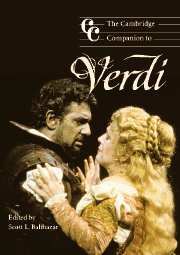Book contents
- Frontmatter
- Part I Personal, cultural, and political context
- Part II The style of Verdi's operas and non-operatic works
- 4 The forms of set pieces
- 5 Newcurrents in the libretto
- 6 Words and music
- 7 French influences
- 8 Structural coherence
- 9 Instrumental music in Verdi's operas
- 10 Verdi's non-operatic works
- Part III Representative operas
- Part IV Creation and critical reception
- Notes
- List of Verdi's works
- Select bibliography and works cited
- Index
4 - The forms of set pieces
from Part II - The style of Verdi's operas and non-operatic works
Published online by Cambridge University Press: 28 September 2011
- Frontmatter
- Part I Personal, cultural, and political context
- Part II The style of Verdi's operas and non-operatic works
- 4 The forms of set pieces
- 5 Newcurrents in the libretto
- 6 Words and music
- 7 French influences
- 8 Structural coherence
- 9 Instrumental music in Verdi's operas
- 10 Verdi's non-operatic works
- Part III Representative operas
- Part IV Creation and critical reception
- Notes
- List of Verdi's works
- Select bibliography and works cited
- Index
Summary
Like his predecessors, Verdi relied on an elaborate system of conventions – termed the “customary forms” (“solite forme”) of set pieces (or “lyric numbers”) by Abramo Basevi in 1859 – for organizing introductions, arias, duets, and finales. Gradually narrowing the diversity of approaches found at the end of the previous century, composers such as Gioachino Rossini, Vincenzo Bellini, and Gaetano Donizetti had “standardized” designs sufficiently that even a provincial critic such as Carlo Ritorni, writing in 1841 about Bellini, could formulate accurate templates for the most extended version of each form. However, while adhering to shared outlines composers also revised internal details for new dramatic effects, a process that Verdi embraced in his own operas. Whereas Rossini's lyric numbers had summarized relationships presented in the scena or reacted to its events, Verdi's take an increasingly expository role in the foreground action, weakening the traditional polarized relationship between an active scena and static lyric number. Dramatic continuity is paralleled by continuity of musical style: the more frequent appearance of lyrical melody in the scena and declamatory singing in lyric numbers allows more flexible expression and stronger characterization in both sections. Innovative treatment of individual movements within the lyric numbers also enhances dramatic momentum, undercutting traditional dichotomies between active and reflective passages and weakening musical disjunctions. Verdi made the presence of these forms less obvious and adapted them to more diverse dramatic circumstances by varying the internal designs of movements, omitting movements, interpolating additional sections (particularly in extended ensemble scenes), and changing the complement of characters within scenes.
- Type
- Chapter
- Information
- The Cambridge Companion to Verdi , pp. 47 - 68Publisher: Cambridge University PressPrint publication year: 2004
- 23
- Cited by



